ABOVE: Driver Abe Lerner and cinematographer Larry Haynes of the Hawaiian Water Patrol (HWP) motor out to the lineup during the 2023 Eddie Aikau Big Wave Invitational at Waimea Bay. HWP has pioneered life-saving techniques in big waves using jet skis. Surfers, in turn, take bigger risks when HWP is on duty—making the sport both safer and more spectacular.
Waimea looks like the inside of a washing machine. Its normally crystalline waters churn with a ferocious, foamy whitewash (soup, surfers call it) that surges with such intensity it swallows the famous jump-off rock, towering at twenty-five feet, like a snake might devour an egg.
A handful of jet skiers rev their engines, the purring sounds lost among the thundering of the waves. They zigzag parallel to the shore, wakes invisible in the violent eddies. Just when it seems that the sea will swallow them, they make sharp, perpendicular turns, zooming away from the oncoming froth, then veer parallel to the coast again—an oceanic cat-and-mouse game—until the moment is right to hurl themselves directly into the wall of water. After punching through, they speed toward the lineup, where the best big-wave surfers in the world compete in surfing's most prestigious, gnarliest contest, the Eddie Aikau Big Wave Invitational.
Terry Ahue, one of the leaders of this group of jet skiers, known as the Hawaiian Water Patrol, observes from the beach with a patch over his left eye from a recent surgery. The rising sun is barely above the horizon, but already the highway, hills and beach around Waimea are swarming with spectators. "This was our first rescue of the day," Ahue jokes, gesturing to a radio in a waterproof case. "It fell off a ski."
That low-stakes save was a warm-up for HWP's main job: rescuing surfers in the monstrous sets. "The Eddie" runs only when wave faces consistently reach forty feet or taller—about the height of a four-story building. "The bay calls the day," goes the saying, meaning that Waimea decides whether the annual competition will run at all, and the day has been called only eleven times over the past forty years or so. Thanks to a storm 1,300 miles north of Hawaii, the felicitous combination of good winds and giant swell made last December's Eddie one for the record books.
While the competitors focus on the waves, HWP tracks everything else: the swell, the changing tides, currents, surfers bobbing in the ocean or waiting on shore to be taken out for their heat, the crowds on the beach that risk getting washed out by a surge. "I feel much safer when they're out there with me," says big-wave maestro Kai Lenny after returning from his first heat. "We can push the limits when we have guardian angels nearby."
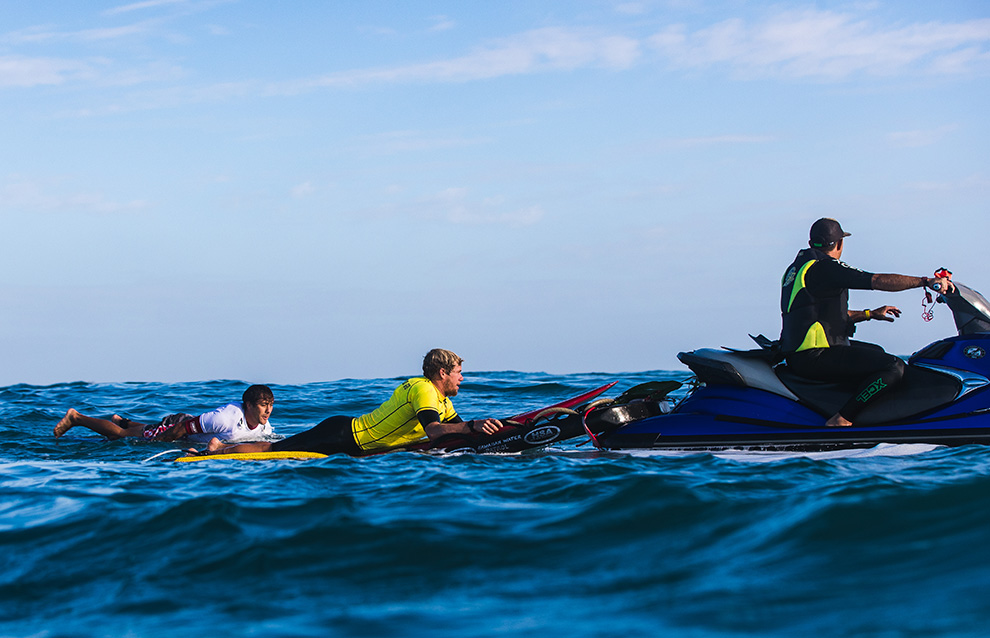
John John Florence and Koa Rothman hang onto the sled, which HWP invented after the 1985 Eddie Aikau, on a ski driven by Kyle Pao at the 2024 Eddie.
Ahue and fellow lifeguard Brian Keaulana founded HWP in 1985. "We were using a rescue board, fin and tubes, and we'd be out there trying to save people on a day like this," Ahue says, gesturing to the bay. They'd use their limited vacation time to patrol contests like the Eddie and the Pipe Masters. During the 1985 Eddie, Keaulana had the idea to use jet skis for rescues. "I was a competitor and I wiped out," he recalls. As he gasped for breath between sets, his friends Squiddy Sanchez and Herbie Fletcher, a tow-in surfing pioneer, came barreling in on stand-up jet skis to check on him. Even though they couldn't rescue him, "I flipped out that someone came into the impact zone," Keaulana says.
That night, Keaulana bought all the personal watercraft (PWC) magazines he could find. Yamaha had launched the world's first sit-down model, the Wave Runner, that year. Ahue and Keaulana wanted to test the hypothesis that they could use jet skis to rescue surfers in big waves. "Stay out in front," the rental guy in Haleiwa said, and so Ahue and Keaulana promptly rode to Pipeline and Velzyland and all the way to Turtle Bay, nearly seven miles away. They practiced saving one another—with little success—until they hit on an idea: the sled, a buoyant board secured to the back of the jet ski that surfers could grab onto. (The early iterations, made with Melvin Puu, a former lifeguard and another founding member of HWP, were makeshift: bodyboards drilled with holes and fitted with handles made from water hoses.)
Today, Ahue and Keaulana, now 72 and 64 years old respectively, are revered for pioneering the use of PWCs for ocean rescues. Along with Puu, they lobbied to change state laws and allow the use of jet skis for rescues in 1991. They have written curricula for Hawaii's Ocean Safety lifeguard teams and travel the world teaching their techniques. They coordinate and perform stunts for big-budget movies like Jurassic World: Fallen Kingdom and television shows including the Hawaii Five-0 reboot. In addition to contests, the organization generates income from film stunts and ocean risk management training programs.
It's obvious the ocean community holds them in high esteem. Every surfer at the Eddie—Kai Lenny, Kohl Christensen, Koa Rothman, Nathan Florence—pays respect and embraces Ahue and Keaulana as they walk the beach. Even saying "Hawaiian Water Patrol" and "Uncle Brian Keaulana" gets me $10 off parking, entrance to the cordoned-off, police-patrolled beach zone and access to the staff-only bathroom (two Porta Potties manned by a security guard). To be in their orbit is to be a VIP.
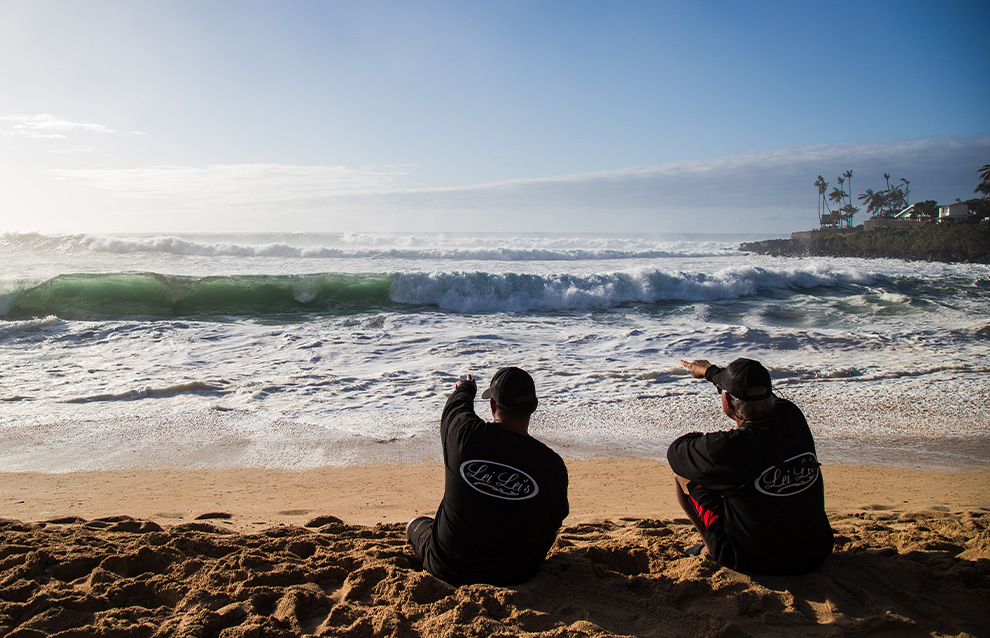
The HWP land crew monitors the swells and tides to keep surfers and spectators safe during the contest.

HWP keeps an eye on surfers making massive drops, but there are moments, like this one at the 2024 Eddie, when ski drivers have to look out for themselves or get cleaned up.
The contest starts at 9. Light, variable winds whip the sea mist into a haze. Ahue and Keaulana stand on the beach with preternatural steadiness, their tan faces etched from a lifetime in the sun. They talk pidgin and everyone calls them uncle.
I stay on the beach with the all-volunteer HWP land crew. From here the ocean looks nothing like it does on the livestream, where drone shots reveal the water's aquamarine brilliance and the waves' heavy tubes. Mostly the sets look massive and white, and the surfers seem like they're falling in semi-vertical lines down the faces.
The volunteers are a motley crew, dressed in something like a makeshift uniform: dark sports sunglasses, hats, boardshorts and black technical long-sleeve shirts with HWP's name and logo: a kii pohaku (Hawaiian petroglyph) riding a jet ski. One volunteer, Tanoai Reed, is a dead ringer for Dwayne "The Rock" Johnson: all traps, no neck, dimples and a shaved head. (Turns out Reed is the Rock's stunt double.) At 15, Tia Haunui Helm is the youngest volunteer. "It's my identity," he says, braces gleaming. "Being a waterman and learning from the greats." The oldest is 58.
Recruitment for HWP is informal and local-style. "There is no application," says volunteer Josh Sumait. Every ski operator and volunteer is someone in the group's husband, son, nephew, co-worker or friend (Sumait is Ahue's son-in-law). The work is seasonal, based on the winter swells. For everyone involved it's more of a lifestyle than a reliable job.
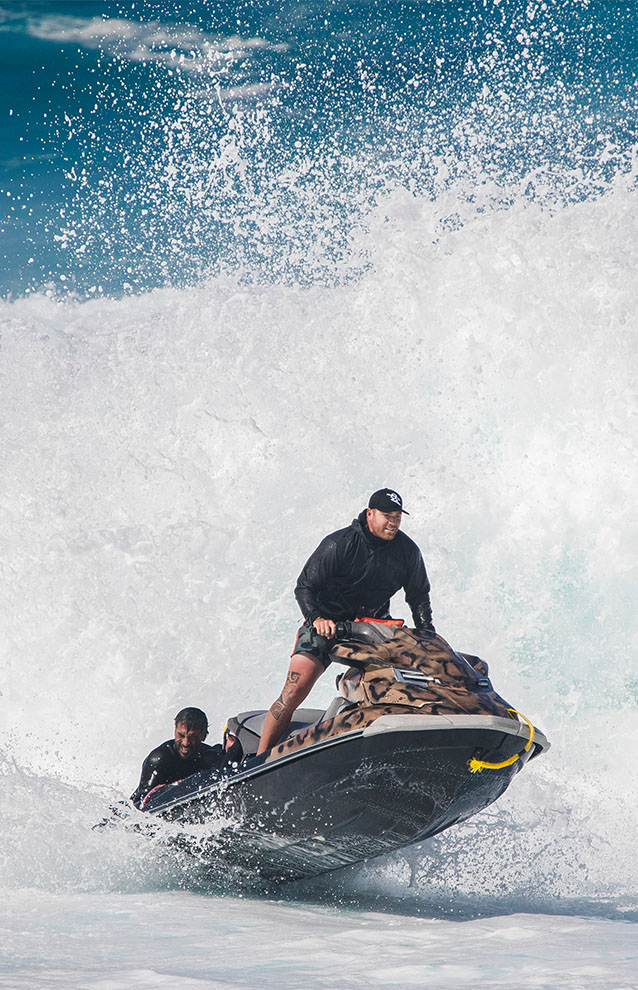
Ski operator Kamakani Froiseth and grabber Kamu Davis at the 2025 Da Hui Backdoor Shootout.

Skis weigh nearly a thousand pounds when waterlogged, requiring many hands to maneuver them.
"Game day is part of our training," says Clif Botelho, a contractor for HWP and Honolulu Fire Department member, when asked how HWP prepares for the Eddie. "But it doesn't happen very often." In other words: The only way to be in the conditions is to be in the conditions. Instead of fire, these guys undergo trial by water. "Creating safety where safety does not exist" is one of HWP's tenets. To do it, they devise an operational logic within the otherwise ungovernable sea. They separate the contest area into two sections—inside where the waves have broken, and outside near the lineup—each with three safety zones: red, yellow and green. During the Eddie there are no green zones, only red and yellow. The "safest" place in the water is the "keyhole," an entry/exit point at the eastern end of the beach, where a phalanx of jagged rocks jut at unforgiving angles and the shorebreak is as harrowing as the big takeoffs outside. This is where surfers, surrounded by fans a few feet away, launch into the maelstrom before paddling hard to the nearest jet ski, which ferries them to the lineup.
This assist is for timekeeping reasons, as each heat is only forty-five minutes. (All competitors surf two heats and can catch a maximum of four waves each round.) The Eddie forbids tow-ins, where a jet ski pulls a surfer into a huge wave. "Eddie wouldn't tow," goes the saying here, a play on the contest's oft-repeated phrase, "Eddie would go." Eddie Aikau was the North Shore's first lifeguard, stationed at Waimea. He was an exceptional Hawaiian waterman, surfer and sailor. He died after paddling for help when the Polynesian voyaging canoe Hokulea capsized off Molokai in 1978. The rest of the crew was rescued, but Aikau was never seen again. The competition began in 1984 as a way to celebrate his legacy and reputation for surfing waves over thirty feet, when no one else would go.
While the Eddie is sometimes called the Super Bowl of surfing, a more apt comparison for HWP is a combination of Formula 1 and an ultramarathon. "We're not the star drivers," says volunteer Kyohei Brewer. "We're putting on the tires." Land crew guys like him wrangle the jet skis when they come ashore. They sprint up and down in the sinking, calf-burning sand at a moment's notice to execute their duties. At least fifteen people are needed at any time to attend one ski.
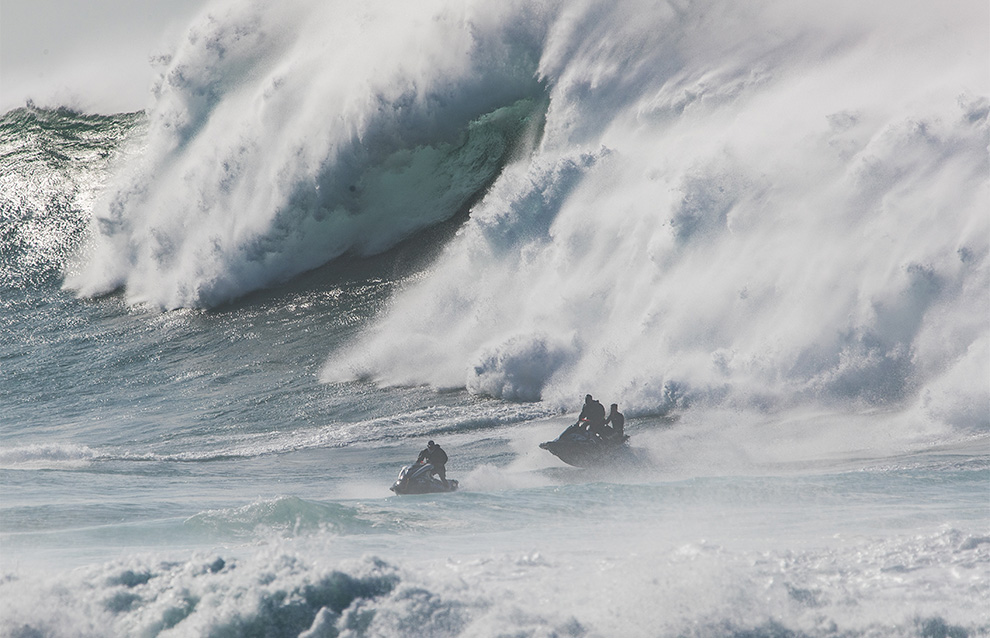
A massive closeout set during the 2022 Eddie sends jet ski operators gunning for shore.
During a routine catch-the-ski-on-the-beach moment, one machine did a perilous 360-degree roll on the sand, nearly crushing Sumait and Justin Camacho. "It coulda been bad," Sumait says when he returns to the beach, his eyes glinting. A thin stream of water buoyed the waterlogged ski, which can weigh about a thousand pounds, saving them from injury, he says. "You could say that about the whole day," Camacho laughs. "Coulda been bad-but wasn't."
Camacho's assessment comes not even midway through the contest, suggesting it's going to be a long afternoon. But when a ski landing onto the beach goes right, it's a cinematic moment. Like skiers outrunning an avalanche, the driver guns toward shore while gargantuan waves chase them. The skis glide onto the beach, sometimes a good fifteen feet up from the waterline. Though it looks effortless, it's anything but.
"You want a carpet of water," says Puu, pointing out the thin layer of whitewash sinking into the sand. The slightest bump in the water or fold in the sand could send a ski flying at the wrong angle, hurling the driver over the handles. Puu is quick to say that he, Keaulana and Ahue didn't invent that maneuver. Keaulana's father, Buffalo Keaulana, another storied waterman, pioneered it using a Boston Whaler at Makaha.
The ski operators are in the water an hour before the contest begins, and they stay out until the last heat is over unless their ski malfunctions. The grabbers-the guys on the back of the ski who physically grab the surfers-work in two shifts. The goal is to make rescues between five to ten seconds: to motor into where a surfer has wiped out before the next set comes in. The water unit all eats lunch-a buffet of breakfast burritos and manapua (bao buns) wrapped in tinfoil with oranges and Red Bulls sealed in Ziploc bags-while they're working in the ocean. Compared with the surfers, who rest on the beach for roughly four hours between heats, these guys are endurance athletes.
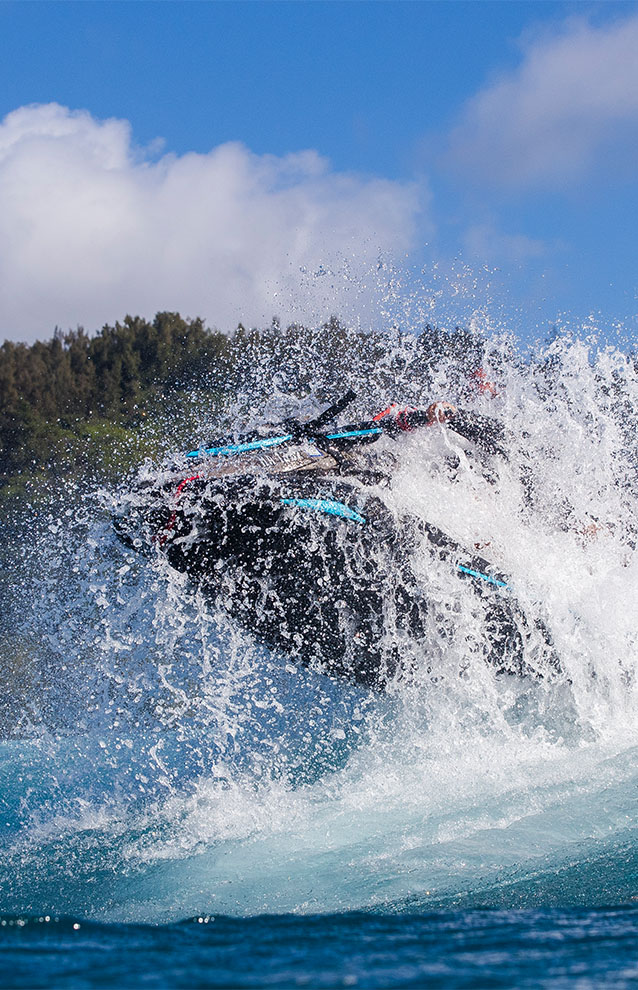
Noland Keaulana punches through the lip at the Da Hui Backdoor Shootout. "I feel much safer when they're out there with me," says big-wave surfer Kai Lenny. "We can push the limits when we have guardian angels nearby."
"Let's effing go!" shouts Tiare Lawrence, one of the ten women competing. She grabs her "gun," a surfboard shaped for big waves, and heads for the water, her pink-and-white rashguard becoming a speck against the sand. It's round two, heat two, and the ocean is peaking. The surfers dig hard to make it over the crests.
"How were those big waves?" Ahue, seated in a beach chair, asks when Lawrence returns. "Freaking scary!" she says. "I'm just happy I stood up on two waves." Lawrence, who was born and raised on Maui, views the patrolmen as her brothers. "I feel protected when I can look out into a channel and know they have my back," she says. There's a lot at stake for her: "I'm a single mom of two kids. I have to go home at the end of the day." When I ask Liam McNamara, the contest director and brother of renowned big-wave surfer Garrett McNamara, what it means to have HWP involved, he says, "It means we don't run unless they say we run. It means we know nobody is going to die. At the end of the day, this won't ever happen without them."
As the event progresses, everyone agrees there's more jet ski carnage than the last Eddie in 2023, which means the conditions are gnarly. Earlier in the morning it seemed that the waves wouldn't be big enough. No longer. "It's legit Eddie Aikau," Botelho says of the swells after working as a grabber during the second round.
At one point deep into the afternoon, Puu and his 15-year-old son, Noa, struggle during a launch from the beach. The engine sputters, and a wave knocks Puu into the whitewash. Noa clambers up from the sled and into the driver's seat, trying to regain control. But his dad had pulled out the kill switch-which turns off the ski and keeps it from motoring away-so Noa sticks his finger in the ignition, trying to restart the engine. Another wave comes, hurling the ski vertically into the air and catapulting Noa off. (They retire the ski, and Noa walks around icing his shoulder for the remainder of the contest.)
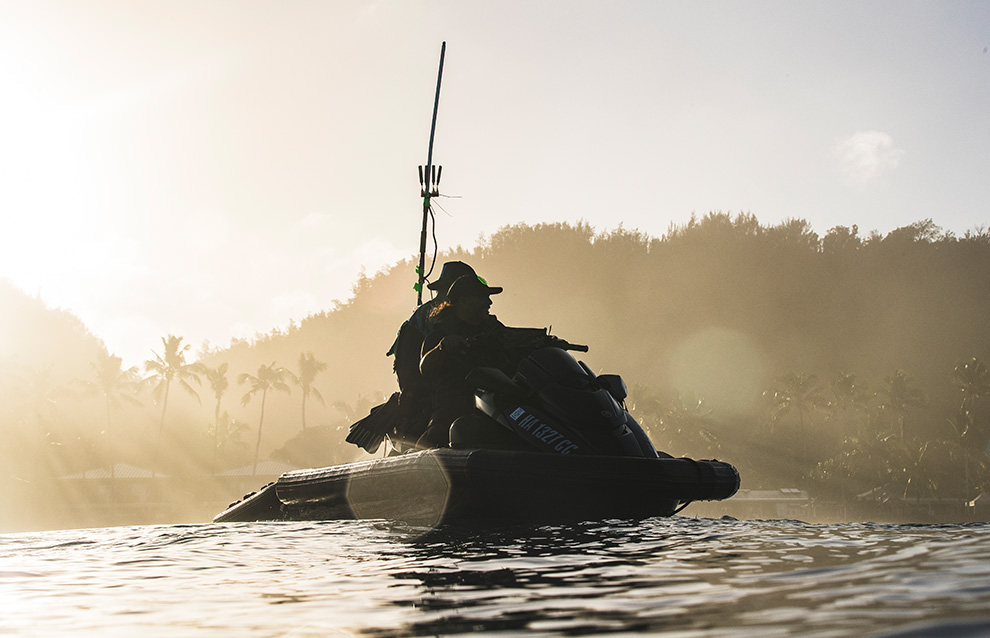
Driver Pomai Hoapili and a water cinematographer relax during a calm moment at the 2025 Da Hui Backdoor Shootout.
In another nail-biter moment, Noland Keaulana, Brian's nephew and current Ocean Safety lifeguard, capsizes his ski in the shorebreak. It bounces like a bumper car into the air, then rolls, sending Noland and his grabber into the swirling soup. It takes almost thirty volunteers and a few lifeguards to haul it down the beach. Miraculously, the ocean pushes the ski upright all the way toward shore, but Noland and his companion don't pop up for a few long seconds. After flushing the engine of seawater, Noland shakes it off and heads back on duty.
"It's straight carnage," says Chris Stacy, a North Shore lifeguard who's working as a grabber. "There's a bunch of chaos, guys going for broke and sending it at the biggest event in the world." Stacy has just finished his shift, and his wetsuit is still soaked. His eyes are dilated with adrenaline. "What does the water feel like?" I ask. He looks out to the horizon, almost frustrated by the futility of articulating the ineffable. "It feels like mini earthquakes," he finally says. "It sounds like rumbling thunder, and when the water crashes down, you feel the shaking. It's scary, honestly."
Surfing big waves is always a life-or-death proposition. In January 2023, Noland and HWP saved and resuscitated Kala Grace, who was knocked unconscious during the Da Hui Backdoor Shootout at Pipeline. Although these surfers are experts, the best in the world, and the feeling on the beach is convivial, the specter of mortality—that massive wave, the pounding shorebreak, an unforgiving reef—is always close by.
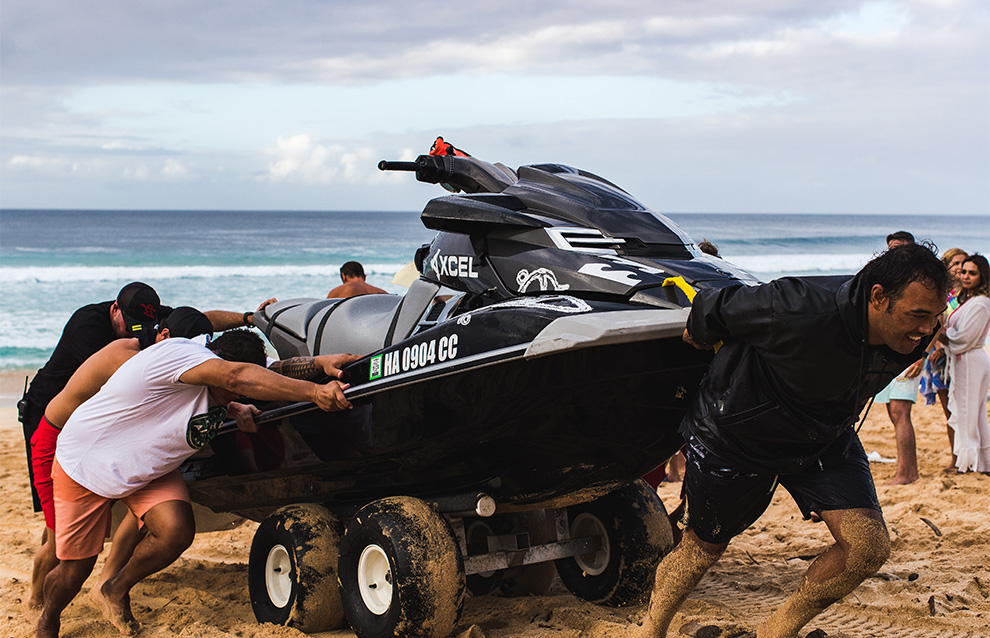
Land crew volunteers haul a jet ski up Ehukai Beach during the finals of Da Hui Backdoor Shootout.
"People come here to fulfill their fantasy and get whacked by reality," Brian Keaulana says. It's almost the end of the contest, and his demeanor throughout has been like an ancient tree in a storm: completely unwavering. While Keaulana is talking about surfing big waves, the subtext runs deeper: To the uninitiated, Hawaii is paradise, and the ocean is a peaceful backdrop for vacation photos. Many don't understand its power or sufficiently respect it. Just before the Eddie, two visitors drowned in high surf at Shark's Cove, a popular North Shore snorkeling spot.
"If you don't like learn in school, the ocean going to teach you and hold you underwater, and you're gonna pray to God," Keaulana says as we watch the final heat. As he sees it, the ocean is their academy, their church, and they are its lifelong students and disciples. "You practice the process and everything falls into place," he says of preparing for the Eddie. "If you let your emotions control your actions, that's when everything falls apart."
"Outside set coming in!" Keaulana alerts everyone on the radio. "Oh, that's one bombah. It's one big one!" The swell rises and peaks fast. "Oh, thirty seconds, thirty seconds," until the final heat is over. The surfer wipes out. "Who is that?" Keaulana asks. A muffled voice comes through the line. "That was Chad?" Chad is his son. Keaulana goes quiet. One wave crashes, then another. There's no word on whether Chad has surfaced yet. The horn blares, ending the contest. I don't dare ask a question. Finally someone radios, confirming Chad is OK.
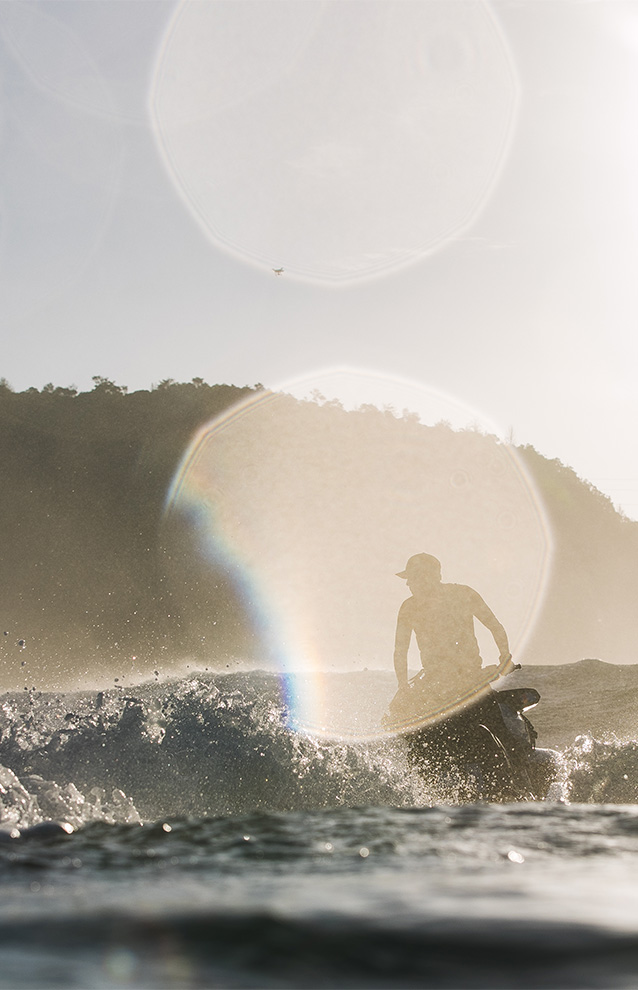
Jeff Okuyama cruises Waimea Bay before the start of the 2023 Eddie.
"Pau—contest ova," Keaulana exhales, using the Hawaiian word for "finished." It's almost nine hours after HWP first launched into the bay. The sun has mellowed into a postcard sunset for which Hawaii is known: sherbet skies and an orange orb setting over a still pumping quicksilver ocean. Amateur surfers, salivating all day, immediately paddle out.
With Keaulana's call, the remaining jet skis bolt toward shore. It looks like the end of an action movie, but there is no dramatic climax, which means HWP, along with Ocean Safety and the numerous state organizations involved, has done its job. By the end there are no deaths or severe injuries. Mark Healy popped an eardrum. Greg Long tore his left medial collateral ligament (again). Laura Enever gets a gash on her right thigh from her board in the whitewash. Ross Clarke-Jones shredded his left hand on his gun's damaged fiberglass. Everyone in the HWP section, many of whom have been there since Saturday night, snaps up their colorful beach chairs. They shake the sand from their towels, take down the pop-up tents. The small shantytown, erected only for the competition, will be gone by nightfall.
A few hundred feet away, the winners are crowned. The surfers stand onstage as a small crowd of diehards gather around. Landon McNamara wins first place thanks to a perfect-scoring wave during round two and pockets $50,000. During this hullabaloo the water patrolmen heave the skis onto trailers and hitch them to pickup trucks. There is no podium, no press, no photographers, no lei, no kids waiting for autographs. "I wish they would give the water patrolmen a trophy," I'd overheard a woman say earlier in the day. "They're busting their asses."
Unlike surfing, this job is all guts, no glory. But glory isn't really the point. As Momi Puu, Mel's wife and Noa's mother, said before the contest's start, "You hear some heavy stories." Two years ago a surfer thanked her son after Noa pulled him out of the water. "You saved my life!" But there are funny tales, too, she says—the way you laugh to keep from crying. "'Holy shit, we're gonna die!'" she recalls a guy named Mikey Red telling her husband. "But they made it," she shrugs. Then she says what strikes me as the ultimate reward for HWP: "You live to tell your story."


